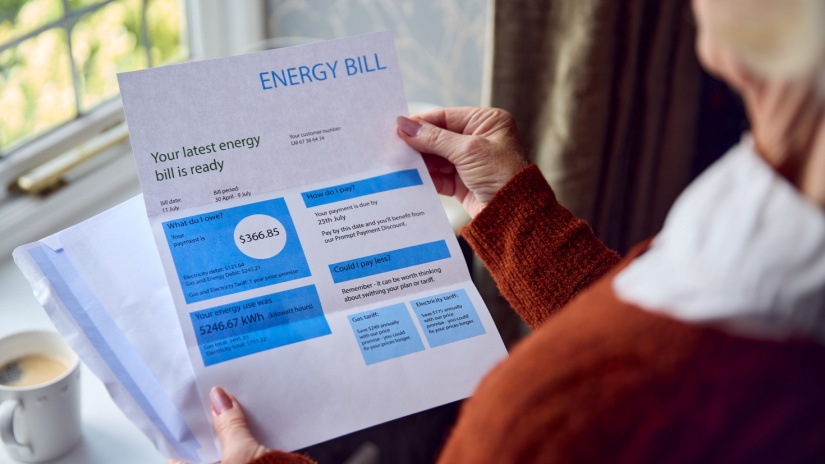Knowledge Centre
Breaking down your electricity bill

Understanding your energy bill is like deciphering a map: it’s easy to do if you know what you’re looking at. Your ability to figure out your electricity bill is essential for managing your household budget effectively.
While electricity bills may not be the most exciting read, learning how to interpret them is crucial for discovering ways to lower your energy costs.
Instead of simply glancing at the amount due and paying, take a moment to examine your bill closely. By understanding each section of your energy bill, you can gain insights into your usage patterns and uncover opportunities to save money.
Let's break down the various components of your bill to help you grasp your expenses and discover potential savings.
Terms to look out for on your electricity bill
There are a lot of terms listed on an electricity bill and understanding these can get you a step closer to figuring out your bills. Every bill is laid out differently but here are the critical terms to watch out for:
Kilowatt hour
What it means: This is a unit of energy your electricity is measured in. You might see it as kWh.
Unlike gas, which is measured in megajoules, electricity is measured in kilowatt hours. This will tell you how many units of electricity you have used in your bill term.
Off-peak
What it means: This is the period of time outside of the peak hours where you’ll be charged less for your electricity usage.
Some plans offer cheaper electricity for off-peak usage, so you can use your bill to see how many hours you were charged at a lower rate.
Peak
What it means: This is the period of the day where there is high electricity demand. Usually, this is the hours after work during Netflix watching or cooking time.
Some plans will charge a higher rate for peak hour usage, and seeing that on your bill may encourage you to use your appliances in off-peak hours for a cheaper price.
Controlled load
What it means: This is electricity that runs on a separate circuit in order to facilitate high-need appliances, such as underfloor heating or a hot water system.
This will tell you how much energy you’ve used on specific appliances, and can help you to determine whether you need to cut down your usage.
Usage rate
What it means: This can tell you how much you are charged in cents per kWh for your usage.
For example, our recent article on average electricity costs in Australia can give you the lowdown for your state, but your bill is more specific. You can use this to assess whether you are on an expensive plan, and whether you should switch.
Supply charge
What it means: The other cost to be aware of is how much you are paying for your electricity supply, and this is the amount you’re charged per day just being connected.
You can use this charge to determine whether or not you need a new plan or a cheaper one.
National Metering Identifier (NMI)
What it means: This is your 10 or 11 digit number that identifies your connection to the power network.
When you make the choice to switch providers, you can use this number as part of the process.
Tariff
What it means: This is the method by which your energy is charged.
You might be on a single rate tariff, which charges you the same amount per kWh for all your usage, or a time of use tariff. The time of use - or variable - tariff changes depending on when you use your electricity.
How to read your electricity bill
Your electricity bill, sent by your energy provider, shows the amount you owe based on your energy use, typically for a month or quarter.
The most important details on your energy bill are typically at the top. This section includes:
- Account reference number
- Account name
- Tax invoice number
- Date of the bill and billing period
- Supply address
- Retailer’s phone number
- Distributor’s phone number
You'll need these details if you need to discuss your energy plan, bill, or account with your retailer. This access is usually available to the primary account holder, joint account holder, or named authorised contact.
The supply details, such as the property address and billing period, are also here, along with your current energy plan information. For business locations, it's wise to keep a copy of the invoice for tax purposes.
Your retailer's contact details are also on the bill for general inquiries or complaints. In case of faults or emergencies, you can reach out to your distributor, whose contact information is also listed.
Under the Better Bills guidelines, retailers must inform you of its best plan for you every 100 days (quarterly in Victoria). Under these same guidelines, energy companies must include specific details on bills to aid consumer understanding.
This includes using simple language, clear design, highlighting the best offer, and placing crucial information prominently.
Account information
The initial section of your bill provides a summary of your account. Here, you'll find the bill's issue date, your account details, National Meter Identifier (NMI), and contact information for your retailer’s customer service team.
You’ll also find contact information for your network distributor for faults and emergencies.
Metre details
Metre details on your bill include:
- Supply address
- Metre number (National Metering Identifier [NMI])
- Billing period (number of days charged)
Metre reading (actual or estimated)
Estimated bills are based on past consumption and other factors, issued when your metre can't be read or based on your metre type; basic metres are typically read quarterly.
Some retailers allow you to submit your own reading. There are three metre types: basic, interval, and smart, each affecting your bill differently.
Having your metre details ready is helpful for comparing electricity plans when switching retailers, and including them in an online application can speed up the process.
This section of your bill often contains overlooked but potentially valuable information for reducing energy usage. You'll typically find:
- Usage charge: Shows electricity usage charges, including peak, off-peak, and shoulder rates.
- Supply charge: A fixed daily fee regardless of electricity use.
- Reading type: Indicates if your metre reading was actual or estimated.
- Quantity: Total usage used to calculate your bill costs, taken from the metre reading.
Usage calculation
In this section you’ll typically find:
- Daily supply charges: This is the daily fee for grid connection, typically in cents per day. It reflects your electricity usage habits compared to other households in your area.
- Usage charges: This is the cost per kilowatt-hour (kWh) of electricity you use. Your retailer calculates this based on any peak, off-peak, shoulder, and controlled load rates in your energy plan.
The bill's calculation table shows your energy usage and charges for each rate during the billing period. The total amount due (including GST) is what you owe for your energy usage in that period.
Discounts and best offer messages
This bill section is a recent addition for households in NSW, SEQ, SA, the Australian Capital Territory, and Tasmania.
It indicates if customers could save on their energy bill by switching to their retailer's "best offer," based on its past 12-month usage. This information is mandated by the Australian Energy Regulator (AER) and includes instructions on switching to this plan for those interested.
Following the metre details and usage, you'll also find discounts, fees, and concessions (if applicable) that can help reduce your electricity bill. These may include:
- Guaranteed discount: Applied without conditions for a specified period.
- Conditional discount: Applied if you meet specific criteria, such as timely bill payment.
- Rebates for eligible concession card holders.
- Sign-up bonuses, one-time incentives, or loyalty credits.
- Credit card fees for paying bills with a credit card.
- For new homes, a connection fee is charged by the distributor.
- Solar feed-in tariff for exporting excess electricity, reflected as a credit on your bill if you have solar panels.
Payment information
Payment details on your bill include the total amount due, highlighted prominently, along with the due date and any additional conditions, such as a payment plan.
It's crucial to review your bill for any discrepancies before the due date.
If there are no additional conditions, payment options are typically listed at the bottom of the page. These may include BPAY, direct debit, credit card, mail, or payment in person at an Australia Post outlet.
Instructions on how to pay are provided, but if you encounter any issues, you can always contact your energy retailer for assistance. If paying by cheque, you'll need to detach and send the payment slip with your cheque.
This information is usually at the bottom of the first page, with a summary of the amount owed on the right and payment instructions above. Following these steps should make paying your bill straightforward.
Can I reduce my current electricity bill?
Reducing your power bill involves more than just understanding your bill—it's about taking action based on that understanding.
For instance, if you notice that your bill has high supply charges despite low electricity usage, it might be time to search for a plan tailored for low-use households.
Keeping a close eye on the electricity rates you're paying can help you spot any unexpected price hikes from your provider. While your provider must inform you of any increases at least five business days beforehand, it's still wise to stay vigilant.
If you are ready to make a switch, why not talk to one of our Compare Energy experts? We’ll demystify your electricity bills and talk you through the process of switching providers.

